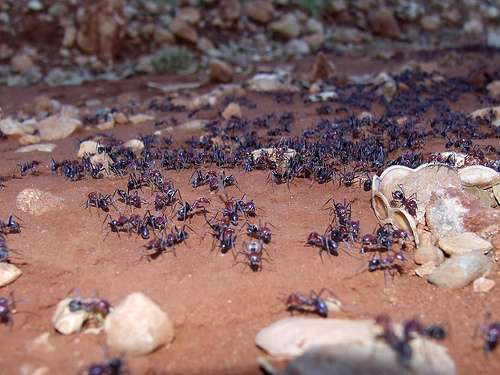Differences over time in the abundance of ant populations

Thirty-seven thousand captured ants tell a story of how after a fire they thrive, leave and return hundreds of years later to areas of the Great Western Woodlands (GWW).
Department of Parks and Wildlife and CSIRO Land and Water Flagship research scientist Dr Carl Gosper has found differences over time in the richness and abundance of ant populations by considering specialist groups of ant species as hot or cold climate specialists.
While overall ant species richness, abundance and composition did not show any clear patterns after fire, the specialist ant groups did when they were investigated.
"The hot climate specialists show a high abundance and richness in the more open habitats offered by recently burnt and long unburnt vegetation" Dr Gosper says.
"However the cold climate specialists show a peak at intermediate times since fire when tree and ground fuel cover is at its highest."
Dr Gosper's research is unique in that it includes areas with very long times since fire, with some areas that haven't been burnt in more than 300 hundred years.
"I decided to carry out the research because I have always been interested in the response of animals to events like fire," Dr Gosper says.
Capturing technique easy to accessible
"Even though the response of ants to change is quite well known, there was an opportunity to include long time since fire areas. Ant capture techniques are easily available too.
"Now there is more information about ant response in areas with very long times since fire."
Dr Gosper, fellow researcher Magen Pettit and a team of French students collected more than 37,000 ants during a three week period, from 51 sites within forest fire scars in Yellowdine, Karroun Hill and Parker Range.
The sites were classified by time since fire intervals as young, intermediate or mature.
Each site had 20 pitfall traps consisting of specimen containers filled with ethylene glycol, in a five by four grid pattern with 10m spacing that were opened for 48 hours.
CSIRO ant specialists Ms Pettit and Dr Andersen counted the ants and sorted them into species.
"This data can be used to build on the theory of assembly of animal communities and how species respond to fire initiated changes in habitat," Dr Gosper says.
"It can also contribute to fire management planning and the conservation of the GWW's globally significant biodiversity."
More information: "Multi-century dynamics of ant communities following fire in Mediterranean-climate woodlands: Are changes congruent with vegetation succession?," Forest Ecology and Management, Volume 342, 15 April 2015, Pages 30-38, ISSN 0378-1127, dx.doi.org/10.1016/j.foreco.2015.01.006
Journal information: Forest Ecology and Management
Provided by Science Network WA




















